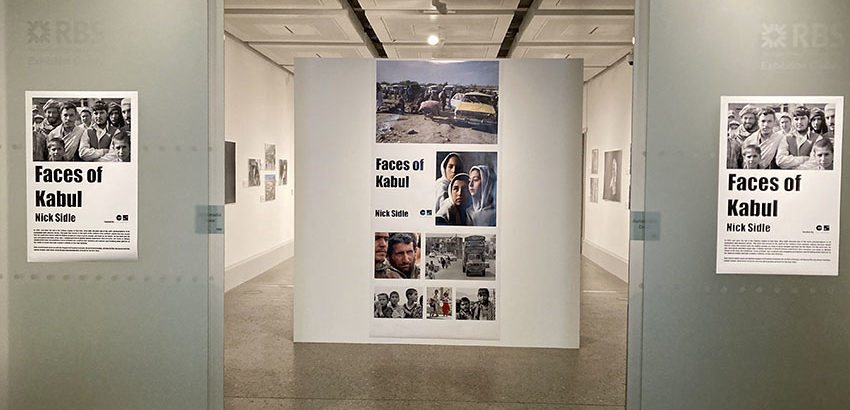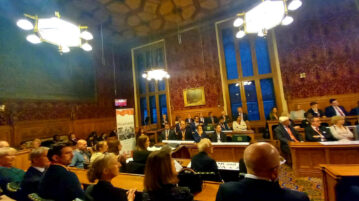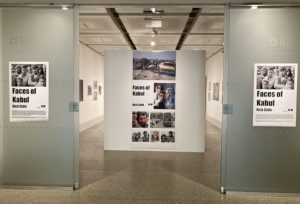
On March 19th 2022, ‘Faces of Kabul’ , the photodocumentary exhibition produced by Nick Sidle, staged by Heartstone with partner Glasgow Afghan United, opened at Kelvingrove Art Gallery & Museum in Glasgow, one of Glasgow’s most prestigious exhibition venues, with an audience of VIP guests, and representatives of the Afghan community resident in the city.
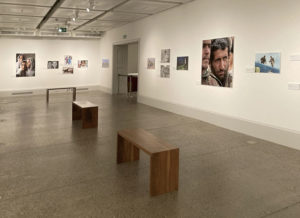
Each individual image took people into the world of Afghanistan in 2002, six months after 9/11, through the lens of Nick Sidle’s camera, to tell, as with all Heartstone stories, the human story beyond politics and conflict. Produced with special access at the time through ISAF, the International Security Assistance Force, the story was presented across the UK, including locations such as the British Library, the House of Commons and European Parliament. It was funded by Creative Scotland for Nick as the individual artist in 2020 to time with the 20th anniversary of 9/11. With the events unfolding in Afghanistan in August 2021 however, the exhibition took on a new significance. First presented at Eden Court, in Inverness in October 2021, the Kelvingrove staging was the second in Scotland with further presentations now in planning.

From street scenes, to set the atmosphere at the time, to individual portraits of a little girl with a skipping rope made of wire, totally wrapped up in her own world, the now famous photo of the boy with a cow on a string, or the danger of standing on top of a tanker which could be carrying a hidden explosive device, the striking woman in a white hijab and three girls on their first day in school, the images portrayed life and the resilience of the Afghan people, regardless of the setting, and their interaction with the ISAF soldiers, the International Security Assistance Force who formed the peacekeeping mission at the time.
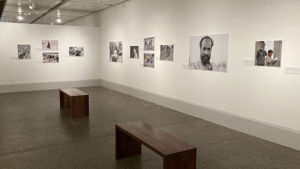
Particularly powerful were the images of schools, shelled out buildings with no roof and no windows but with female teachers seen for the first time after many years. One of the schools featured was Mehrabudien Shahied School, its rebuilding concluded in time thanks to funds from children in Heartstone Story Circles across the UK who, having seen the photos, wanted to do something to help. The new school was opened by the Mayor of Kabul to coincide with and from Heartstone’s ‘Faces of Kabul’ exhibition event in Birmingham in 2002.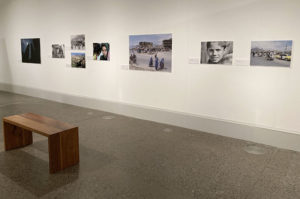
The exhibition opened with the image of the twin towers in New York, one of Nick’s earlier photo assignments, pre 9/11 in New York, reminding audiences of the start of this story and why it had happened.
The following was one of the opening statements for the exhibition from Eamonn McCabe, former Picture Editor of The Guardian and Presenter of Britain in Focus, a history of photography:
‘As we see today in Ukraine, photographers are often the first to witness history. Newspapers want to show the horror of war, often to people who don’t want to look. How far do you go? When I was picture editing The Guardian the earthquake in Armenia happened that killed 50,000 in twenty seconds! Many including me didn’t even know where it was. Ironically it was a Soviet republic and I ran a photograph on the front page the next day that showed a mother with her arms akimbo screaming for her family that had been lost in the rubble. I got so much abuse for invading this poor lady’s private grief and the readers were right, but i wanted to tell 500,000 readers that such a huge thing had happened in place that they couldn’t even point out on a map. In the next few days fire crews, rescuers with dogs and volunteers from all over Britain were on their way to help. That is the power of news photography! But when the T.V. cameras and the glamorous presenters have gone home and local people start to rebuild their lives the real photographers move in, the documentary brigade. These photographers are not after glamour but truth. What is happening in schools, with housing with relationships? The photographs are not as stark as bombed towers and tanks on the streets, the tension may have gone from the faces of the locals.
These pictures are hard to get published, the story has often moved on to another continent but the real story is the remarkable strength of people trying to rebuild their cities, their towns, their families. And this is where photographers like Nick Sidle come into their own. It will be hard to get The Faces of Kabul shown now around the country with Ukraine on T.V. every night but this is the real story, this is what happened after the bombs dropped.Let’s hope that Nick Sidle goes to Ukraine in the years to come and make another powerful essay of what it is like for people to survive outrageous times that for many of us we can only imagine.
Please tell your friends that once Kabul was on the front pages and come and see this powerful show.’
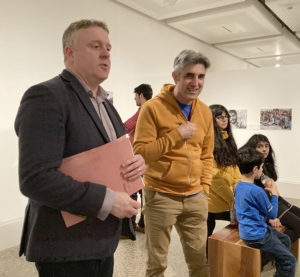 Special guests Mr Bob Doris, MSP (at left) and Dr Sabir Zazai, CEO Scottish Refugee Council, (second from left) opened the exhibition and highlighted the ongoing need to keep the story of Afghanistan in the public eye.
Special guests Mr Bob Doris, MSP (at left) and Dr Sabir Zazai, CEO Scottish Refugee Council, (second from left) opened the exhibition and highlighted the ongoing need to keep the story of Afghanistan in the public eye.
Bob Doris MSP (Member of the Scottish Parliament for Glasgow Maryhill and Springburn constituency) said:
“The recent events in Afghanistan have given ‘Faces of Kabul 20+’ a new and urgent focus. There is no doubt there will be a great poignancy to the exhibition and it is a powerful message of support from Scotland’s largest city which has a sizable Afghan community.
“It is a great act of solidarity with the people of Kabul and Afghanistan, particularly the women and children. They have seen their safety, human rights and civil liberties cruelly snatched from them. Having the ‘Faces of Kabul 20+’ exhibited at one of our city’s flagship galleries captures the hope, energy and enthusiasm the people of Afghanistan had for the future which was so brutally snatched away by The Taliban.
“This exhibition reminds us we have our part to play in helping the people of Afghanistan recapture that future”.
Dr Zazai said:
“Afghanistan has endured decades of dreadful conflict and this has left the whole population in precarious conditions. Millions are internally displaced and others are forced to flee to seek protection in neighbouring countries and further afield around the world. We live in uncertain and unfamiliar times and we must not forget the ongoing sufferings of our fellow human beings in Afghanistan at this critical time. The Faces of Kabul exhibition will remind you of impact of decades of war but also the courage, resilience and hopes of ordinary Afghans. If ‘a picture is worth a thousand words’, in Afghanistan’s case it takes thousands of pictures to tell the stories of sufferings Afghans have endured; and this exhibition aims to deliver just that in creating a timely conversation about Afghanistan and its people.”
Rt Hon Gordon Brown, former Prime Minister of the United Kingdom & UN Special Envoy for Global Education, said:
“Amidst the bullets and bombs of a war in Europe, no one must be allowed to forget the suffering of millions of Afghan people – hungry, cold and displaced in their own country. And no one should forget the plight of millions of girls who yearn for education but are still denied the opportunity to go to school. Faces of Kabul is a powerful and moving exhibition that should and must ensure that the tragedy of starvation in Afghanistan remains in the public eye.”
Other key guests and speakers included Mr Abdul Bostani, Director of Glasgow Afghan United, who partnered with Heartstone for the staging of this exhibition and brought representatives of the Afghan community in Glasgow to the event. He is pictured below, first on right, next to Sitakumari and one of the guests at the exhibition. Next to Dr Zazai and Mr Bob Doris, MSP, is Chairman of the Scottish Ahlul Bayt Society, Mr Shabir Beg, who has become another important supporter for the next staging of ‘Faces of Kabul’.
Lt Col, (read) Jon Heap, Commanding Officer of the 1 Royal Anglian regiment Nick was embeddd with in Kabul, joined with a specially recorded message from Canada where is stationed now.

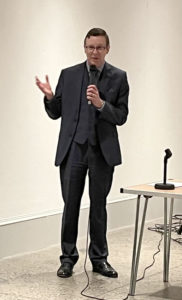 Mr Duncan Dornan, Head of Glasgow Museums, (right) welcomed all special guests to the launch and spoke of the importance of the exhibition for Glasgow. Mr Bob Doris spoke of the value of seeing the human story and a story captured in real time without staging. Dr Zazai highlighted the need to keep the story of Afghanistan alive alongside the unfolding tragedy in Ukraine.
Mr Duncan Dornan, Head of Glasgow Museums, (right) welcomed all special guests to the launch and spoke of the importance of the exhibition for Glasgow. Mr Bob Doris spoke of the value of seeing the human story and a story captured in real time without staging. Dr Zazai highlighted the need to keep the story of Afghanistan alive alongside the unfolding tragedy in Ukraine.
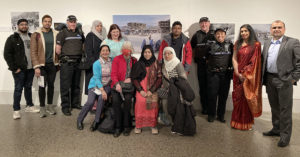
Travelling across from Edinburgh, Nila Joshi, founder of the Edinburgh Women’s Interfaith Group, brought several of the women to the launch event, pictured on the left.
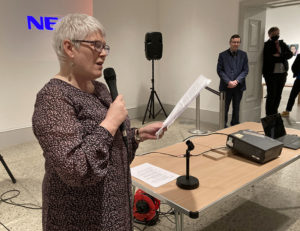
Dr Maureen Sier, Director, Interfaith Scotland, spoke of the relevance of ‘Faces of Kabul’ in the context of people coming together across all faiths.

PS Diane Mitchell, Community Policing, brought police colleagues to the event. Pictured here with Sitakumari and Mr Abdul Bostani, all are assisting with continuation of the Story Circle programme and also the work with young people across Glasgow North.
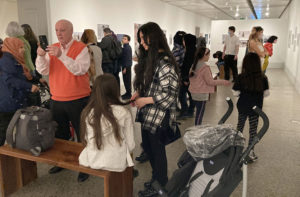
‘Faces of Kabul’ attracted an audience of all ages and backgrounds and has been a great success whilst at Kelvingrove. It is now under discussion for presentation for Interfaith Week in Scotland on a bigger scale and other locations across the UK and beyond.
Our grateful thanks for the support of Creative Scotland, Glasgow Life, Glasgow Museums, Glasgow Afghan United and Edinburgh Women’s Interfaith Group in the staging of the exhibition at Kelvingrove Art Gallery & Museum and Paul Hamlyn Foundation for their support towards the online events staged from the exhibition.

